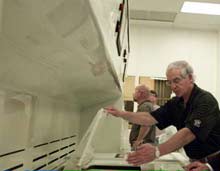Rice University: New Process Reduces Solar Cell Cost
In conventional solar cell fabrication, a low temperature liquid deposition process is used to add an anti-reflective film to the silicon wafer to help absorb more light. At the same time, a variety of quantum dots are used to effectively absorb sunlight in the full-band wavelength.
A novel approach to the preparation of thin, uniform coatings, developed by Rice University, can reduce the cost of traditional silicon solar cells and open the way to new solar cells that are more efficient Cheaper, better than traditional batteries.

Solar Machines: The CEO of Knight Cole Technologies is demonstrating a prototype AR box (AR-Box) that uses a new liquid deposition technique with an anti-reflective coating.
Source: MIT Technology Entrepreneurship
This technology deposits coatings using a low-temperature liquid phase process rather than the high-temperature gas phase process now in use. Now, Natcore Technology is commercializing. The startup is in New Jersey. ) Red Bank. The company plans to use this technology to replace the standard step by adding an anti-reflective film to the silicon wafer to help them absorb more light. This will also bring a more advanced anti-reflective technology called black silicon.
At the same time, Knight Cowell is developing more advanced processing applications, including the use of carbon nanotubes or nanocrystals when manufacturing solar cells, which are called quantum dots. This type of solar cell takes several years to be commercialized, but it is far superior to traditional solar cells. Nano-solar cells have been tried before, but the company believes that its new manufacturing technology can make them cheaper.
This liquid-based process can reduce manufacturing costs because it replaces the high temperature process of conventional production lines. Knight Cowell's president, Charles Provini, estimates that replacing traditional coating machines with their company's machines can save solar manufacturers about $1 million in annual electricity costs.
Manufacturers currently do not use liquid phase processes to prepare antireflective films, in part because it is difficult to make the coatings sufficiently uniform for use in solar cells. The problem is the way the liquid process usually runs. This coating forms a reactant that interacts with the surface in the liquid. When this reactant is depleted, the deposition rate changes, resulting in a change in the thickness of the coating. Researchers at Rice University solved this problem by developing a system that would continue to replenish the reactants while closely monitoring the thickness of the film.
Knight Cowell's advanced nano-solar cell design requires the deposition of quantum dot layers on silicon solar cells. This quantum dot design absorbs some of the color that silicon cannot absorb, which may double the efficiency of the solar cell. This has been tried before, but the formation of a layer of quantum dots requires expensive processing techniques and it has proven difficult to arrange quantum dot spacing to avoid unnecessary discharges between them. NetCraft's low-cost process provides a way to control the arrangement of quantum dots by applying a layer of silicon dioxide to form spacers when applying them. The company has decided to first apply traditional silicon solar cells to make it easier and make it easier for the industry to adopt this technology. However, it may eventually give up silicon wafers and make solar cells that rely entirely on quantum dots. A variety of quantum dots are used to effectively absorb sunlight at full-wavelength wavelengths.
Another design, Knight Cowell, is working with Kodak to develop a thin-film flexible solar cell using a liquid deposition process, depositing a carbon nanotube network, and using a solar-based semiconductor material. According to Knightkell, solar cells use this design to be as efficient as traditional silicon solar cells, but at a cost of about half, they can be made, in large part because of their preparation, using Kodak. The company's equipment is the same equipment used to make photographic film. Because this solar cell is light and flexible, it is also easier to install and the installation cost will be cut in half, Knight Cowell estimates.
Andrew Barron, a professor of chemical and materials science at Rice University, who developed the liquid deposition technology, said that the carbon nanotube design is closer to commercialization than the excessive sub-point design. He said that the researchers have made prototypes of small solar cells, and the rest of the development work must continue to develop production details. Such quantum dot solar cells are still in their early stages, and researchers have so far only used this liquid process to show that the distribution of these quantum dots can be met. They have not yet made solar cells.
Knight Cole has raised about $6 million because of public offerings on the Canadian Stock Exchange. It also signed joint venture agreements with companies in China and Italy. The company plans to license its technology to others instead of making solar cells by itself. The company is currently testing a prototype of a commercial grade liquid deposition machine. Provini said the company has four solar cell manufacturers that are lining up to purchase the commercial version of the machine, as long as the company meets certain technical standards.
Prepainted Color Coils,Pvdf Coil,Color Prepainetd Coil
Prepainted Steel Coil/sheet/strip Roofing Sheet Co,Ltd , http://www.nssteelcoil.com